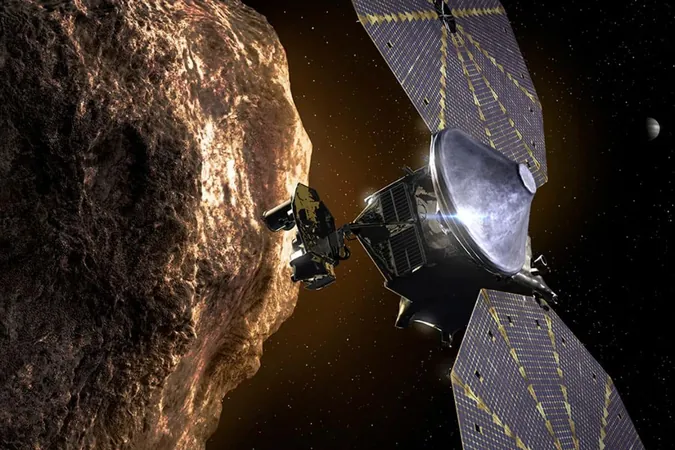
NASA Launches Quest to Examine a 150-Million-Year-Old 'Space Fossil' – What Secrets Will It Unveil?
2025-03-21
Author: Kai
NASA Launches Quest to Examine a 150-Million-Year-Old 'Space Fossil' – What Secrets Will It Unveil?
On April 20, 2025, NASA's ambitious Lucy mission is set to execute a groundbreaking flyby of the mysterious asteroid (152830) Donaldjohanson. This asteroid is believed to be a fragment of a larger celestial body that shattered in a cosmic collision more than 150 million years ago. This encounter not only serves as a crucial milestone in Lucy's extensive journey toward the Jupiter Trojans but also provides a unique opportunity to test the mission’s advanced instruments while gathering invaluable data on an ancient remnant of our solar system’s history.
Named after the influential paleoanthropologist who co-discovered the famous hominin fossil, the Lucy asteroid encapsulates the essence of the mission's goal: to trace the "fossils" of planetary formation. Recent studies highlighted in The Planetary Science Journal suggest that the surface of Donaldjohanson may have undergone significant processing due to micrometeorite impacts and thermal fracturing, phenomena that the upcoming observations aim to elucidate.
A Glimpse into the Past: The Enigmatic Donaldjohanson
First discovered in 1984, Donaldjohanson is a testament to cosmic endurance. Its namesake, the paleontologist who unearthed the crucial Lucy fossil, reshaped the narrative of human evolution, and now this asteroid is set to leave a mark on planetary science. Research indicates that Donaldjohanson originated from a larger asteroid that fragmented, becoming part of the Erigone collisional asteroid family. Scientists are intrigued by how its orbit and rotational dynamics have shifted over eons due to thermal torques.
Dr. Simone Marchi, a deputy principal investigator of the Lucy mission, emphasized the asteroid's uniqueness. "Understanding the formation of Donaldjohanson could unlock answers to its unusual characteristics," he stated.
Paving the Way to the Trojan Asteroids
Launched on October 16, 2021, the Lucy spacecraft is embarking on a 12-year odyssey set to explore 11 asteroids, including the enigmatic Trojan asteroids in orbit with Jupiter. These ancient relics are considered remnants of the solar system's earliest days. Before Lucy reaches the Trojan swarms, its flyby of Donaldjohanson will serve dual purposes: it’s both a vital scientific investigation and a pivotal test for the spacecraft’s navigation systems.
Dr. Hal Levison, the mission's principal investigator, accentuated the significance of this precursory step: "Our encounters with main belt asteroids not only provide a hands-on look at these cosmic bodies but also enable us to conduct essential engineering tests on the spacecraft’s innovative navigation system before we delve into our main mission with the Trojans."
Unraveling Potential Connections to the Solar System
Located in the inner main belt, Donaldjohanson sits near the origin points of well-known near-Earth asteroids like Bennu and Ryugu. Both have been extensively studied by missions such as NASA's OSIRIS-REx and JAXA's Hayabusa2, which returned samples revealing crucial insights into planetary formation. However, Donaldjohanson is believed to differ significantly from its counterparts; while Bennu and Ryugu are characterized by their loose structures and carbon-rich makeup, Donaldjohanson predominantly consists of silicate rocks and may contain clays and organic materials.
The upcoming flyby will provide critical data to help scientists assess any relationships between these ancient bodies and establish a more comprehensive understanding of the solar system's evolution.
What Lies Ahead?
So far, most knowledge regarding Donaldjohanson has stemmed from Earth-based observations and theoretical modeling, which offer only a limited view of its shape, composition, and internal structure. The Lucy spacecraft, equipped with cutting-edge imaging and spectroscopic technologies, promises to deliver the first detailed examinations of this extraordinary asteroid.
As we await this momentous flyby, the scientific community is buzzing with excitement. What secrets will this 150-million-year-old space fossil hold? The discoveries made by the Lucy mission could reshape our understanding of asteroid evolution and the formative years of our solar system. Stay tuned for updates on this spectacular celestial event!


 Brasil (PT)
Brasil (PT)
 Canada (EN)
Canada (EN)
 Chile (ES)
Chile (ES)
 Česko (CS)
Česko (CS)
 대한민국 (KO)
대한민국 (KO)
 España (ES)
España (ES)
 France (FR)
France (FR)
 Hong Kong (EN)
Hong Kong (EN)
 Italia (IT)
Italia (IT)
 日本 (JA)
日本 (JA)
 Magyarország (HU)
Magyarország (HU)
 Norge (NO)
Norge (NO)
 Polska (PL)
Polska (PL)
 Schweiz (DE)
Schweiz (DE)
 Singapore (EN)
Singapore (EN)
 Sverige (SV)
Sverige (SV)
 Suomi (FI)
Suomi (FI)
 Türkiye (TR)
Türkiye (TR)
 الإمارات العربية المتحدة (AR)
الإمارات العربية المتحدة (AR)